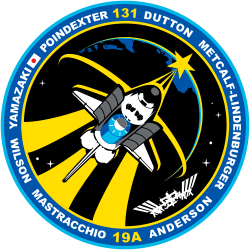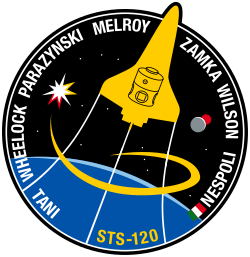Stephanie Wilson
| Stephanie Wilson | |
|---|---|
 | |
| Land: | USA |
| Organisation: | NASA |
| ausgewählt am | 1. Mai 1996 (16. NASA-Gruppe) |
| Einsätze: | 3 Raumflüge |
| Start des ersten Raumflugs: | 4. Juli 2006 |
| Landung des letzten Raumflugs: | 20. April 2010 |
| Zeit im Weltraum: | 42d 23h 46min |
| Raumflüge | |
Stephanie Diana Wilson (* 27. September 1966 in Boston, Massachusetts, USA) ist eine US-amerikanische Astronautin.
Ausbildung
Die Eltern Eugene und Barbara Wilson zogen von Boston in die Kleinstadt Pittsfield (Massachusetts), als ihre Tochter ein kleines Mädchen war. Dort besuchte Wilson nach der Stearns Elementary School die Crosby Elementary School und schließlich die Taconic High School. 1984 begann sie ein Studium an der berühmten Harvard University in Cambridge. Kurz nachdem die Bildungsstätte ihr 350-jähriges Bestehen feierte, machte Wilson 1988 ihren Bachelor in Ingenieurwissenschaften. Außerdem erhielt sie von der University of Texas 1992 einen Master in Luft- und Raumfahrttechnik.
Nach ihrem Abschluss an Harvard, arbeitete Wilson für zwei Jahre bei der Martin Marietta Astronautics Group in Denver (Colorado), die seit 1995 Lockheed Martin heißt. Sie führte Spannungsberechnungen durch, um die auftretenden Belastungen auf eine Titan-IV-Rakete beim Start zu analysieren. Anschließend setzte sie ab 1990 ihr Studium in Texas fort. Sofort nachdem sie die University of Texas verlassen hatte, fand sie eine Anstellung am Jet Propulsion Laboratory (JPL) in Pasadena (Kalifornien). Sie war Mitglied des Lageregelungskontroll-Teams der Galileo-Sonde. Sie zeichnete insbesondere für die Ausrichtung der wissenschaftlichen Plattform und der Antenne verantwortlich. Daneben arbeitete Wilson an einem Interferometrie-Programm des JPL.
Astronautentätigkeit
Stephanie Wilson wurde im April 1996 für das Astronautenprogramm der NASA ausgewählt. Die zweijährige Grundausbildung begann für sie und ihre 34 Mitschüler(innen) im August. Seit Herbst 1998 ist sie eine vollwertige Missionsspezialistin. Es folgte eine Weiterbildungsphase, in der sie sich mit Experimentabläufen auf der Internationalen Raumstation (ISS) vertraut machte. Danach arbeitete sie einige Zeit als CapCom, bevor sie in die Abteilung Raumfährenbetrieb versetzt wurde, wo sie sich mit den Antriebseinheiten des Shuttles beschäftigte.
Wilson erhielt ihren ersten Auftrag für einen Raumflug im Dezember 2002. Zusammen mit James Halsell als Kommandant, Alan Poindexter als Pilot, sowie Piers Sellers, Wendy Lawrence und Mike Foreman als Missionsspezialisten, sollte sie die Besatzung von STS-120 bilden. Der Versorgungsflug zur ISS war für Februar 2004 vorgesehen und sollte mit dem Verbindungsmodul Harmony die Station weiter ausbauen. Wegen des Columbia-Unglücks ein Jahr zuvor musste die Flugplanung des Shuttle-Programms umgestellt werden.
STS-121
Im November 2004 wurde Stephanie Wilson der Crew von STS-121 zugeteilt. Die Mission wurde nach mehreren Verschiebungen im Juli 2006 durchgeführt. Hauptaufgaben waren einmal nachzuweisen, dass die nach STS-107 und STS-114 angegangenen Verbesserungen am Space Shuttle funktionieren, und zum anderen, die ISS mit Gütern zu versorgen sowie deren zweiköpfige Besatzung durch einen Astronauten zu verstärken. Damit arbeiten seit der ISS-Expedition 6 wieder drei Raumfahrer auf der Station. Außerdem führte die Shuttle-Crew drei Außenbordarbeiten durch, bevor der Flug nach zwei Wochen zu Ende ging. Zusammen mit ihrer Kollegin Lisa Nowak war sie bei diesem Flug für alle Arbeiten mit den Roboterarmen verantwortlich.
STS-120
Wilson wurde Ende Januar 2007 erneut für die Mission STS-120 nominiert. Bei der Neubekanntgabe der Mannschaft im Juni 2006 wurde sie zunächst übergangen. Ein halbes Jahr später wurde Michael Foreman STS-123 zugeteilt und Wilson rückte nach. Sie war Missionsspezialistin des STS-120-Fluges, der zwischen dem 23. Oktober und 7. November 2007 durchgeführt wurde.
STS-131
Am 5. Dezember 2008 wurde Wilson als Missionsspezialistin für die Mission STS-131 benannt.[1] Der Start erfolgte am 5. April 2010, die Landung am 20. April 2010.[2]
Artemis
Im Dezember 2020 wurde Wilson als Kandidatin für Mondflüge im Rahmen des Artemis-Programms ausgewählt.[3]
Privates
Wilson ist verheiratet und hat keine Kinder.
Siehe auch
Weblinks
- spacefacts.de: Kurzbiografie
- Stephanie Wilson auf der NASA-Website – Biografie, Bilder und Videos (englisch; PDF)
Einzelnachweise
- ↑ NASA Assigns Astronaut Crews for Future Space Shuttle Missions. NASA, 5. Dezember 2008, abgerufen am 7. Dezember 2008 (englisch).
- ↑ STS-131 Mission Information. NASA, 20. April 2010, abgerufen am 20. April 2010 (englisch).
- ↑ William Harwood: NASA names 18 astronauts for Artemis moon missions. Spaceflight Now, 9. Dezember 2020.
| Personendaten | |
|---|---|
| NAME | Wilson, Stephanie |
| ALTERNATIVNAMEN | Wilson, Stephanie Diana (vollständiger Name) |
| KURZBESCHREIBUNG | US-amerikanische Astronautin |
| GEBURTSDATUM | 27. September 1966 |
| GEBURTSORT | Boston, Massachusetts, USA |
Auf dieser Seite verwendete Medien
The STS-131/19A crew patch highlights the Space Shuttle in the Rendezvous Pitch Maneuver (RPM). This maneuver is heavily photographed by the International Space Station (ISS) astronauts, and the photos are analyzed back on earth to clear the Space Shuttle's thermal protection system for re-entry. The RPM illustrates the teamwork and safety process behind each Space Shuttle launch. In the Space Shuttle's cargo bay is the Multi-Purpose Logistics Module (MPLM), Leonardo, which is carrying several science racks, the last of the four crew quarters, and supplies for the ISS. Out of view and directly behind the MPLM, is the Ammonia Tank Assembly (ATA) that will be used to replace the current ATA. This will take place during three Extra Vehicular Activities (EVAs). The 51.6° Space Shuttle orbit is illustrated by the three gold bars of the astronaut symbol, and its elliptical wreath contains the orbit of the ISS. The star atop the astronaut symbol is the dawning sun, which is spreading its early light across the Earth. The background star field contains seven stars, one for each crewmember; they are proud to represent the United States and Japan during this mission.
The STS-120 patch reflects the role of the mission in the future of the space program. The shuttle payload bay carries Node 2, the doorway to the future international laboratory elements on the International Space Station. On the left the star represents the International Space Station; the red colored points represent the current location of the P6 solar array, furled and awaiting relocation when the crew arrives. During the mission, the crew will move P6 to its final home at the end of the port truss. The gold points represent the P6 solar array in its new location, unfurled and producing power for science and life support. On the right, the moon and Mars can be seen representing the future of NASA. The constellation Orion rises in the background, symbolizing NASA's new exploration vehicle. Through all, the shuttle rises up and away, leading the way to the future.
The STS-121 patch depicts the Space Shuttle docked with the International Space Station (ISS) in the foreground, overlaying the astronaut symbol with three gold columns and a gold star. The ISS is shown in the configuration that it will be in during the STS-121 mission. The background shows the nighttime Earth with a dawn breaking over the horizon. STS-121, ISS mission ULF1.1, is the final Shuttle Return to Flight test mission. This utilization and logistics flight will bring a multipurpose logistics module (MPLM) to the ISS with several thousand pounds of new supplies and experiments. In addition, some new orbital replacement units (ORUs) will be delivered and stowed externally on ISS on a special pallet. These ORUs are spares for critical machinery located on the outside of the ISS. During this mission the crew will also carry out testing of Shuttle inspection and repair hardware, as well as evaluate operational techniques and concepts for conducting on-orbit inspection and repair.
Official portrait photograph of NASA astronaut Stephanie Wilson, attired in a shuttle launch and entry suit at NASA's Johnson Space Center.



